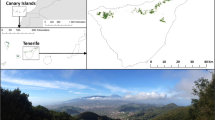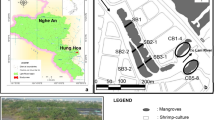Abstract
In northern Patagonia, riparian ecosystems are highly modified due to alien plant invasions. The establishment of non-native willows and poplars has unknown effects for Salix humboldtiana, the only native floodplain tree species in this region. To clarify establishment processes and to assess whether interspecific competition among the Salicaceae taxa may occur and therefore whether the native species can coexist in the long term, we analysed age structure and growth performances of the dominant four taxa within mixed adult forest stands along the Río Negro, Argentina. Low mean ages of <15 years for all four taxa within 20 stands could be detected and suggest frequent and severe disturbances resulting in the removal of existing vegetation and subsequent creation of sites for establishment. Trees of the same stand showed the same age structure indicating joint establishment events with all taxa involved. A significant better growth performance (basal area, crown diameter) could be proved for the invasive willows. Considering the upper and middle river separately in a total of 88 studied plots, S. humboldtiana was more frequent at the middle river stretch, while invasive willows showed an opposing pattern suggesting a downstream directed invasion process. The results showed that competition pressure in mature mixed stands could affect S. humboldtiana. However, these stands are usually removed by river dynamics creating new sediment bars and islands. These processes enable S. humboldtiana seeds to germinate frequently which may compensate for its inferior growth performance and potential impacts by the invasive willows and poplars.




Similar content being viewed by others
References
Adair R, Sagliocco JL, Bruzzese E (2006) Strategies for the biological control of invasive willows (Salix spp.) in Australia. Aust J Entomol 45:259–267
Argus GW (1974) An experimental study of hybridization and pollination in Salix (willow). Can J Bot 52:1613–1619
Bendix J, Hupp CJ (2000) Hydrological and geomorphological impacts on riparian plant communities. Hydrol Process 14:2977–2990
Borodowski ED, Suárez RO (2004) El cultivo de álamos y sauces: su historia en el Delta del Paraná. SAGPyA Forestal 32:5–13
Budde KB, Gallo L, Marchelli P, Mosner E, Liepelt S, Ziegenhagen B, Leyer I (2011) Wide spread invasion without sexual reproduction? A case study on European willows in Patagonia, Argentina. Biol Invasions 13:45–54
Caso SL, Neiff JJ, Neiff AP (2010) Ecological responses of two pioneer species to a hydrological connectivity gradient in riparian forests of the lower Paraná River. Plant Ecol 209:167–177
Catford JA, Downes BJ, Gippel CJ, Vesk PA (2011) Flow regulation reduces native plant cover and facilitates exotic invasion in riparian wetlands. J Appl Ecol 48:432–442
Correa MN (1984) Flora Patagonica. Coleccíon Científica del INTA, Buenos Aires
Crawley MJ (2007) The R book. Wiley, Chichester
Cremer KW (2003) Introduced willows can become invasive pests in Australia. Biodiversity 4:17–24
Cushing CE, Cummins KW, Minshall GW (2006) River and stream ecosystems of the world. University of California Press, Berkeley
Glova GJ, Sagar PM (1994) Comparison of fish and vertebrate standing stocks in relation to riparian willows (Salix spp.) in 3 New-Zealand streams. N Z J Mar Freshw Res 28:255–266
Gut B (2008) Trees in Patagonia, 1st edn. Birkhäuser, Basel
Hauman L, Burkhart A, Parodi LR, Cabrera AL (1947) La vegetation de la Argentina. Sociedad argentina de estudios geograficos, Buenos Aires
Henderson L (1991) Alien invasive Salix spp. (willows) in the grassland biome of South Africa. S Afr For J 157(1):91–95
Holland-Clift S, O’Dowd DJ, Mac Nally R (2011) Impacts of an invasive willow (Salix × rubens) on riparian bird assemblages in south-eastern Australia. Aust Ecol 36:511–520
Hultine KR, Bush SE (2011) Ecohydrological consequences of non-native riparian vegetation in the southwestern United States: a review from an ecophysiological perspective. Water Resour Res 47:W07542. doi:10.1029/2010WR010317
Hunziker JH (1992) The origin of the hybrid triploid willows cultivated in Argentina. Silvae Genet 11:151–153
Karrenberg S, Kollmann J, Edwards PJ, Gurnell AM, Petts GE (2003) Patterns in woody vegetation along the active zone of a near-natural Alpine river. Basic Appl Ecol 4:157–166
Lester P, Mitchell S, Scott D (1994) Effects of riparian willow trees (Salix fragilis) on macroinvertebrate densities in two small Central Otago, New Zealand, streams. N Z J Mar Freshw Res 28:267–276
Li H-L (1996) Shade and ornamental trees: their origin and history. University of Pennsylvania Press, Philadelphia
Moggridge HL, Gurnell AM (2009) Controls on the sexual and asexual regeneration of Salicaceae along a highly dynamic, braided river system. Aquat Sci 71:305–317
Naumann M (1996) Das nordpatagonische Seengebiet Nahuel Huapi (Argentinien). Biogeographische Struktur, Landnutzung seit dem 17. Jahrhundert und aktuelle Degradationsprozesse. Dissertation, University of Marburg
Parolin P, Oliveira AC, Piedade MTF, Wittmann F, Junk WJ (2002) Pioneer trees in amazonian floodplains: three key species form monospecific stands in different habitats. Folia Geobot 37:225–238
Peri PL, Bloomberg M (2002) Windbreaks in southern Patagonia, Argentina: a review of research on growth models, windspeed reduction, and effects on crops. Agrofor Syst 56:129–144
Reinhart KO, Gurnee J, Tirado R, Callaway RM (2006) Invasion through quantitative effects: intensive shade drives native decline and invasion success. Ecol Appl 16:1821–1831
Rejmánek M, Richardson DM (2013) Trees and shrubs as invasive alien species—2013 update of the global database. Diversity Distrib 19:1093–1094
Renöfält BM, Jansson R, Nilsson C (2005) Spatial patterns of plant invasiveness in a riparian corridor. Landsc Ecol 20:165–176
Richardson DM, Holmes PM, Esler KJ, Galatowitsch SM, Stromberg JC, Kirkman SP, Pyšek P, Hobbs RJ (2007) Riparian vegetation: degradation, alien plant invasion, and restoration prospects. Diversity Distrib 13:126–139
Shafroth PB, Scott ML, Friedman JM (1994) Establishment, Sex Structure and Breeding System of an Exotic Riparian Willow, Salix × rubens. Am Midl Nat 132:159–172
Stohlgren TJ, Brinkley D, Chong GW, Kalkhan MA, Schell LD, Bull KA, Otsuki Y, Newman G, Bashkin M, Son Y (1999) Exotic plant species invade hot spots of native plant diversity. Ecol Monogr 69:25–46
Tabacchi E, Planty-Tabacchi A-M, Roques L, Nadal E (2005) Seed inputs in riparian zones: implications for plant invasion. River Res Appl 21:299–313
Thiebault J (1998) Nuclear DNA amount in pure species and hybrid willows (Salix): a flow cytometric investigation. Can J Bot 76:157–165
Thomas LK, Tölle L, Ziegenhagen B, Leyer I (2012) Are vegetative reproduction capacities the cause of widespread invasion of Eurasian Salicaceaein Patagonian river landscapes? PLoS One 7(12):652. doi:10.1731/journal.pone.0050652
Tockner K, Stanford JA (2002) Riverine flood plains: present state and future trends. Environ Conserv 29:308–330
Vilà M, Espinar JL, Hejda M, Hulme PE, Jarošík V, Maron JL, Pergl J, Schaffner U, Sun Y, Pyšek P (2011) Ecological impacts of invasive alien plants: a meta-analysis of their effects on species, communities and ecosystems. Ecol Lett 14:702–708
Ward JV, Tockner K, Arscott DB, Claret C (2002) Riverine landscape diversity. Freshw Biol 47:517–539
Zalba SM, Villamil CB (2002) Woody plant invasion in relictual grasslands. Biol Invasions 4:55–72
Acknowledgments
We would like to thank Prof. Dr. Heinrich Spiecker and the Department of Forest Growth/University of Freiburg where the core samples were analysed and the DPA (Departamento Provincial de Aguas Río Negro), who provided data on the water levels. The GIS-files were provided by Fernando Raffo, the Laboratorio de Teledetección y SIG—EEA San Carlos de Bariloche and the Sistema Nacional de Información hídrica—Cartográfica digital/Subsecretaría de Recursos Hídricos. Many thanks to Katharina Fettweis and Jorge Bozzi for their help during the sample collection. The study was carried out within the project Predicting effects of invasion processes of Eurasian floodplain willows in Patagonia funded by the German Research Foundation (DFG grant LE 1364/4-1).
Author information
Authors and Affiliations
Corresponding author
Additional information
Communicated by L. Souza.
Rights and permissions
About this article
Cite this article
Thomas, L.K., Leyer, I. Age structure, growth performance and composition of native and invasive Salicaceae in Patagonia. Plant Ecol 215, 1047–1056 (2014). https://doi.org/10.1007/s11258-014-0362-7
Received:
Accepted:
Published:
Issue Date:
DOI: https://doi.org/10.1007/s11258-014-0362-7




